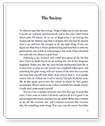Essay Instructions: • Choose ONE from professional Journals of Education
ARTICEL WILL BE IN RESOURCE THAT YOU CAN USE. If you have trouble with tis article please let me know
Articles must be current (within the last five years) and must be related to behavior management.
• Indicate electronic address/source used, following APA guidelines for citing this type of source. (See sample below.)
• Type the article review using Microsoft Word (no other computer program is acceptable; such as Works or Word Perfect).
• Each Article should be accompanied by a title/reference page, as well as in-text citations and a reference page which is only the referenece for the article reviewed. Please adhere to APA formatting.
• Utilize a professional writing style. Do not begin "This article is about..." Open the review with a strong thesis statement and summarize the author's main points in the first paragraph. You may use first person to state your personal reaction to the article in the final paragraph. Each article review should be one to two pages in length. [See sample Article Review.]
APA Tips for References [see samples below]
Author: Last name and initials only. For multiple authors insert "&" before last author.
Date: Year first. In parentheses.
Article title: Capitalize only first word, proper nouns, and first word after colon.
Journal title: Italicized. Standard capitalization.
Volume number: Italicized (continued from journal title). Do not use Roman numerals.
Sample APA Entries
Banbury, M. M., & Hebert, C. R. (1992). Do you see what I mean? Teaching Exceptional
Children, 24, 34-38.
Greene, G. (1992). Multiplication facts: memorization made easy. Intervention in
School and Clinic, 27(3), 150-154.
Mahan, V. (1993). Mnemonics and the learning disabled child. Journal of Special
Education, 17(2), 157-166.
Watkins, Carol. (N.D.) Ad/hd co-morbidity: What's under the tip of the iceberg? Attention Deficit Disorder Association retrieved from http://www.add.org/
Sample Special Education Journals
- American Annals of the Deaf
- American Journal on Mental Retardation
- Behavior Disorders
- Beyond Behavior
- Clearing House
- Diagnostique
- Education and Training in Mental Retardation/Developmental Disabilities
- Exceptional Children
- Exceptional Parent
- Focus on Exceptional Children
- Gifted Child Quarterly
- Journal for the Education of Gifted
- Journal of Learning Disabilities
- Journal of Special Education
- Language and Speech
- Physical Therapy
- Remedial and Special Education
SAMPLE OF REVIEW
Name of Article Reviewed
Student Name
EDUC 624
Professor
Date of Submission
?
Response to Intervention, also known as RTI, is a multi-tiered process which identifies and helps to provide differentiated instruction to students who are experiencing academic and/or behavioral difficulties. RTI consists of multiple tiers of intervention which ranges from whole group instruction to intensive small group instruction (Murawski & Hughes, 2009). This new method affects all parties in the education field including but not limited to regular education teachers, special education teachers, students, and administrators. Murawski and Hughes stated: The RTI emphasis on pro-active instruction, ongoing assessment, data-based decision making, and intensive instruction greatly affects the general education teacher and classroom (p.268). Due to RTI’s unique design Murawski and Hughes proposed collaboration and co-teaching as necessary factors to properly implement any Response to Intervention model.
Most schools use the three-tiered model of Response to Intervention. In Tier I all students are provided with a research-based program in the general education classroom and are assessed three times per year on an established benchmark (Murawski & Hughes, 2009). If students fall below the required benchmark, they are referred to Tier II in which specific intensive instruction is provided in a small group. If a student fails to respond to Tier II instruction it may ultimately result in the child being placed into Tier III. Murawski and Hughes reported that Tier I consisted of approximately 80% of the student population while Tier II consisted of 25% to 7%, and Tier III consisted of approximately 5% of the student population.
Collaboration and co-teaching are critical factors for the success of RTI as noted by Murawski and Hughes (2009). Both provide numerous opportunities for educators to develop research-based practices using the expertise of both, general and special educators. More differentiation can be provided within the regular classroom, and educators have the opportunity to combine their approaches which results in greater learning for all.
I believe that RTI offers a promising outlook to improving the academic achievement of all students. When implemented correctly, RTI appears to be a logical approach. However, as Murawski and Hughes (2009) proposed collaboration and co-teaching are important factors that will greatly aid in delivering an effective model of RTI. Schools must address these issues using a system-wide approach in order to increase the chances of success.
?
References
Murawski, W. W. & Hughes, C. E. (2009). Response to Intervention, collaboration, and co- teaching: A logical combination for successful systematic change. Preventing School Failure, 53,(4), 267-277.
There are faxes for this order.


